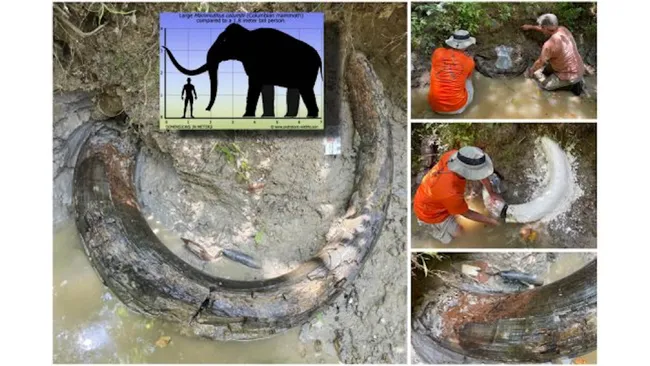An amateur fossil hunter in Mississippi found the first known mammoth fossil in the region — a well-preserved tusk that weighed about 600 pounds (270 kilograms).
While exploring the untamed wilderness of Mississippi, a man recently made an extraordinary discovery—a remarkably well-preserved mammoth tusk jutting out from a steep cliff near a stream. This find marks the first known mammoth fossil uncovered in the region, according to scientists.
Eddie Templeton, an amateur fossil hunter, was meandering through the rural areas of Madison County in early August when he stumbled upon the tusk, partially buried in water and embedded in the silt and clay of the streambed. He promptly reached out to the Mississippi State Geological Survey, leading to the excavation of the fossil, as confirmed by representatives from the Mississippi Department of Environmental Quality (MDEQ).
Survey scientists examined the impressive 7-foot-long (2 meters), 600-pound (270 kilograms) ivory tusk, which was found almost entirely intact. They identified it as belonging to a Columbian mammoth (Mammuthus columbi). “When I found out it was a mammoth and not a mastodon, my excitement grew. I’ve never encountered a mammoth fossil before. It’s something I’ve always dreamed of finding, but it’s incredibly rare in this region,” Templeton shared with The Clarion-Ledger.
James Starnes, a geologist with the MDEQ, also told The Clarion-Ledger that tusks typically don’t preserve well in this area. “It’s not every day you come across something like this,” he remarked. “This was a massive creature.”
Mammoth relatives like the American mastodon (Mammut americanum) are commonly found throughout Mississippi due to their diverse diet and adaptability to different environments. However, mammoths were more selective, grazing primarily in open grasslands, which limited their presence to just two regions within the state.
Columbian mammoths roamed North America during the Pleistocene epoch, approximately 2.6 million to 11,700 years ago, after crossing the Bering land bridge around 1.5 million years ago, according to the National Park Service (NPS). These colossal animals could reach heights of about 15 feet (4.5 meters) at the shoulder and weigh up to 10 tons (9 metric tons).
Mammoths were widespread across North America during the last ice age. However, as glaciers retreated and their habitats diminished, combined with human hunting, these majestic creatures were driven to extinction, as per NPS records.
Columbian mammoths became extinct between 13,000 and 11,000 years ago, while their close relatives, the woolly mammoths (Mammuthus primigenius), managed to survive for an additional 6,000 years. The last known population of woolly mammoths lived on Wrangel Island, a remote Russian island near Alaska, until approximately 3,700 years ago. A recent study suggests a mysterious event led to their sudden demise, challenging previous theories that inbreeding and resulting genetic decline were responsible.
